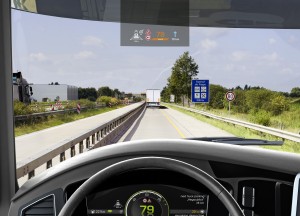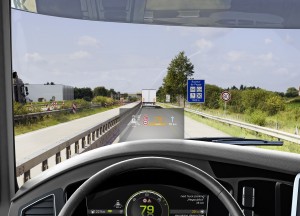It has already conquered the mid-range cars, but it’s still new in the world of trucks – the head-up display (HUD). Continental is one of the world’s first companies to develop a HUD for commercial vehicles and has installed the technology in its own InnovationTruck. Supplementing conventional instrument clusters, the display provides the driver with greater safety and comfort by projecting a color image of important driving information into his field of vision. Continental offers manufacturers the display as a Windshield or a Combiner HUD. Customers can also choose to have the display shown in the upper or lower field of view (look-up or look-down concept).
The display can show many different items of information
The display options and the color schemes of the HUD are very varied and can be freely defined by the vehicle manufacturer. The display gets its data via the CAN bus and depending on the available sources, the display choices range from speed, navigation instructions and traffic sign warnings such as overtaking restrictions and speed limits, to distance warnings, gas tank levels and the driving time remaining until the next break. The driver gets all the important information exactly where he needs it – in his field of view. This increases safety, because he doesn’t have to take his eyes off the road for a second or two, as is the case with a conventional instrument cluster – and his eyes don’t have to focus on a shorter viewing distance before the flow of information starts and then adjust again to the longer-distance view. This refocusing process takes time and tires the eyes after a while.
Four versions – available as a Windshield or Combiner HUD, with the display either shown at the top or bottom of the field of view
The Continental HUD is available as a Windscreen HUD, where the windshield serves as a mirror for the displayed information. This version is ideal for commercial vehicles with flatter windshields which are common in the USA. In the case of the Combiner HUD, a transparent pane (the combiner) handles the image reflection in front of the windshield. This version is particularly suitable for confined spaces with more steeply curved windshields, which are more common in Europe. The vehicle manufacturer can also choose whether the display should be shown in the upper or lower field of view (look-up and look-down approach). Continental offers the Windshield HUD in the look-down version as standard. The use of a head-up display also gives OEMs new opportunities in vehicle design. The instrument panel can be made smaller, for example, because all of its information content can be transferred to the HUD.
Important human-machine interface
“The head-up display makes a significant contribution to road safety. The driver can monitor events without getting tired because his eyes don’t have to continually switch back and forth between long-distance and short-range focusing. The HUD keeps him up-to-date about what’s happening in his vicinity, providing him with information like distance from the vehicle ahead, a traffic jam or sudden weather events like heavy rainfall,” explains Dr. Michael Ruf, Head of Business Unit Commercial Vehicles and Aftermarket. “The HUD is also an important technology in terms of the progressive automation of driving, because in its role as a human-machine interface, it can ideally provide the driver with information about the current automation mode. The driver must believe in the efficiency and performance of the machine and getting this information boosts his confidence.”
In developing the HUDs for commercial vehicles, Continental engineers used synergies within the Group and the know-how of their colleagues from the automobile sector, where Continental has long been a supplier for several manufacturers, delivering the first full-color HUD as far back as 2003. The HUD supports the driver in the Continental Innovation Truck and has been used successfully for more than 17,500 kilometers.













Leave a Reply